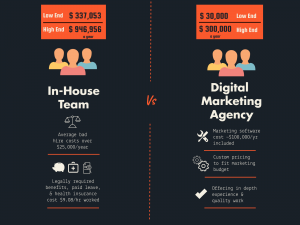
It’s no surprise that analytics are integral to your organization’s success. Whether you work for an in-house marketing team or an advertising agency, tracking and reporting metrics provide you and your team with an overview of your performance. They provide you with insights that influence current and future decisions. And they demonstrate return on investment to internal and external stakeholders.
In other words, business metrics show off the value of your team.
Quantifying ROI across internal creative teams brings with it an extra layer of difficulty. Sure, managers can track the productivity of their team’s work by measuring data such as hours billed, expenses incurred, and costs by project. But how do organizations dig a little deeper and track internal business metrics?
Internal business metrics help paint a bigger picture. They illustrate exactly how your team’s gears are cranking. And, perhaps most importantly, they can help identify areas for growth and improvement. To help illustrate how you can measure metrics across both in-house and agency teams, consider the following tips.
Profitability
Money is the lifeblood of any business. That is why it is critical for creative managers to be aware of the financial consequences of their goals and expectations. Although most managers recognize the importance of aligning creative and financial teams, operational and financial integration is unfortunately not a reality for many agencies and in-house teams.
So, how do teams turn things around and start measuring profitability? For starters, it’s important to track cash flow and gross margin. The former can be measured in terms of the average number of days it takes your team to collect accounts receivable (or payments outstanding), and the number of days it takes to pay your vendors. The latter is a fancy term for the percent of sales your company keeps after incurring direct costs associated with producing your services.
In addition to tracking these metrics, it’s up to you to coordinate the usage of resources to ensure that your projects are completed on time and within budget. Sound overwhelming? Luckily, this process is streamlined and simplified, thanks to accounting software designed specifically for creative teams.
Automating the creation of detailed timesheets, expense reports, and vendor invoices enables you to bill clients efficiently and speed up the AR process. It also eliminates disputes over bills by substantiating all charges and speeds up the collection process by notifying managers when they should follow up on past-due receivables.
Customer interactions
In a survey of nearly 200 senior marketing managers, 71 percent said they considered customer satisfaction metrics useful in managing and monitoring their businesses.
Think that measuring customer satisfaction is difficult and reserved exclusively for large teams? Think again. There are quite a few metrics that can be used to measure just this, including Voice of Customer (VOC)—the process of capturing customer expectations, preferences and aversions—or Customer Satisfaction (CSAT), which measures how products and services meet or surpass customer expectations. However, perhaps no metric is as popular, or easy to track, as Net Promoter Score (NPS).
In a nutshell, NPS measures the willingness of your customers to recommend your products or services to others. It is a loyalty measurement score that can be used as a proxy to gauge your customer’s overall satisfaction with your organization and the customer’s loyalty to your brand. Responses are collected through surveys that ask participants to rank your organization on a scale of 1 to 10.
While NPS provides your team with a 1,000-foot view, it’s still a metric worth measuring. Not only does customer satisfaction outline how well your organization is serving its customers, it helps identify which internal functions need the most attention.
Employee satisfaction
Just as it’s important to measure your customer interactions, it’s equally essential to track the overall satisfaction of your internal teams. They are the driving force of your agency and in-house team, after all. In fact, finding and retaining talent is the top challenge faced by agency executives, according to a recent survey.
Employee turnover or attrition—the reduction in staff through means such as retirement and resignation—is one of the biggest limitations of growth. The best organizations are cognizant of the realities of turnover; they work hard to combat them. This takes more than simply talking about employee happiness. It requires a conscious effort to rethink what engagement means, hold teams accountable, and provide tools that measure and capture employee feedback.
One easy way to measure the mood of your team members is through an employee satisfaction survey. It may sound simple, but a survey is a SMART (specific, measurable, attainable, realistic, timely) way to get an accurate reading of your people. As HubSpot outlines, there are numerous feedback tools that help track team engagement. However, no matter what tool you choose, make sure you utilize it.
Business & Finance Articles on Business 2 Community(117)









